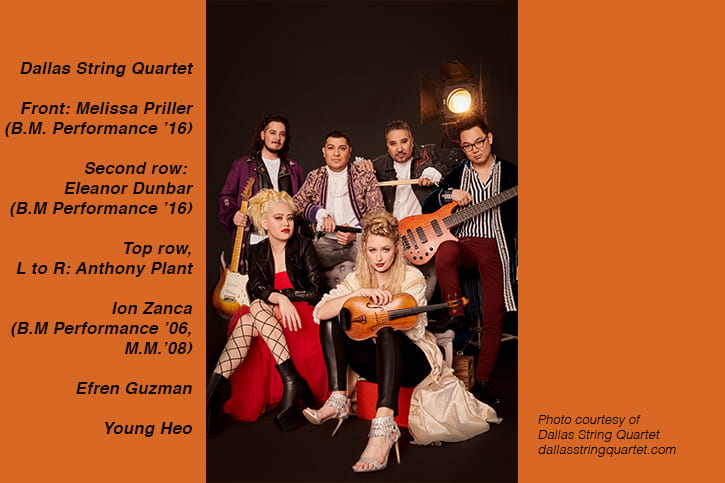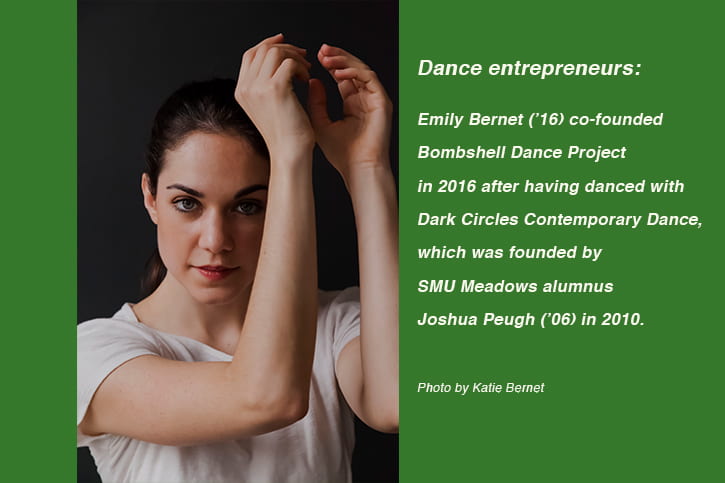When business owner Rodman Steele was a music major at SMU Meadows, he and a group of Meadows friends played in a hot band called Blue Apollo. As the band worked to land gigs and promote recordings, Steele realized that the information he was learning in his arts management and arts entrepreneurship courses at Meadows could help the band’s efforts.
“It became apparent to me that the content of my arts entrepreneurship minor could apply to the popular music industry and the entertainment industry as a whole,” says Steele.
When he graduated in 2018, Steele founded his own company, Rodman Steele Studio. The studio specializes in developing mentorships and creating personalized lesson plans for clients interested in guitar, voice, percussion, jazz, musical theatre and pop music. After just one year in business delivering lessons and workshops in clients’ homes, Rodman Steele Studio is now building its own studio space.
“Everything I learned in AM/AE I use on a weekly basis, from organization to understanding the fundamentals of accounting and finance to managerial skills and how to conduct a team,” says Steele. “The minors accurately prepared me for the challenges that come with building a business. I can think of a lot of direct correlations, but the one that comes to mind first is [professor] Jim Hart stressing that the life of an entrepreneur does not come with a schedule – it’s on the entrepreneur to build the structure and organization for your own company and yourself to get the work done that the company needs.”
The AM/AE draw
What attracts students—art majors, business majors and more—to the arts management (AM) and the arts entrepreneurship (AE) minors? Plenty, says Jim Hart, award-winning director of arts entrepreneurship and professor of practice at Meadows. “Both minors are cross-disciplinary,” explains Hart, “and cross-pollination is something that multi-interested students want and need. They pursue AM or AE minors because one, they want to lead, and two, they want to learn how to perceive opportunities. They learn how to problem-solve effectively, and in turn, learn how problem solving can lead to opportunities.
“They learn to take action,” says Hart. “All of these skills apply to any business endeavor, regardless of field.”
Jump-starting ideas
Belle Campbell is busy. The journalism and fashion media double-major is also pursuing five minors—arts management; arts entrepreneurship; advertising; graphic design; and photography—and serves on the SMU Student Senate. During her first year at SMU, Campbell entered SMU’s annual Big iDeas Pitch competition. She was one of a team of three who pitched Green Book, a magazine focused on SMU’s black community. The team won the competition and published 100 copies of the book, one of which resides in the digital Southern Methodist University Publications and Media Collection.
In her sophomore year, she and colleague Brinn Bailey (B.M. Music Education ’21) pitched a social-impact product called “Sweetie, take care of yourself,” a handmade self-care kit. With each sale, the project donates a kit to a black woman in need. Again, Campbell and her colleague were declared winners in the competition.
“My arts management and entrepreneurship courses taught me everything I’ve used to successfully fund and operate both of my entrepreneurial ventures,” says Campbell. “From ideation to my first sale, my coursework has been the blueprint, and my professors have been there to answer any questions I’ve had. Understanding the business side of things has been integral in making sure the art I create and support has a chance to reach others and affect their lives.”
Plan, budget, market, repeat
While at SMU Meadows, Emily Bernet danced professionally for Dark Circles Contemporary Dance, founded in 2010 by Meadows alumnus Joshua Peugh (’06). Bernet graduated in 2016 with a B.F.A. in dance performance and a minor in arts management. Shortly after graduation, while still dancing for Dark Circles and also teaching at Preston Dance Center, Bernet co-founded Bombshell Dance Project in Dallas. She knows first-hand the challenges of opening and running a business, and that there is much more to running a performing arts company than performing onstage.
“The AM/AE courses I took at SMU prepared me for the practical aspects of running a company, including business planning, budgeting, marketing and grant writing, which gave me a place to start when I set out to co-found Bombshell Dance Project,” says Bernet. “I also gained experience pitching, which was a huge help as I have always been more comfortable dancing than speaking.
“Running an arts organization means having your hands in every aspect of the business,” she says. “The AM/AE program provided me with the perfect mix of practical skills and creative inspiration to prepare me for the challenge.”
Differences between the arts management minor and the arts entrepreneurship minor
The two minors are cousins, says Hart, but they’re not brother and sister.
“Both are about running organizations, about taking leadership roles,” he says. “They are similar, but different. For starters, the arts entrepreneur founds the organization; the arts manager takes on an existing leadership role within an organization that is already established.
“Entrepreneurs manage their vision, their organization, their team, themselves, their financials and otherwise,” says Hart. “They manage all stakeholders in the organization. Being an entrepreneur is an intensive, high-risk endeavor that carries a lot of responsibility.”
For managers, knowing how business works gives you an edge, says Hart. “If you can understand how your company’s business model is structured, how it makes money and how it works,” he says, “then you can perceive potential new partners, new market segments, key resources that might be acquired, how the cost structures might be adjusted, new revenue streams, new channels for delivery and value identified, new value that can be created within the organization. All of this can help make a company more competitive. Via AM/AE classes, you are able to understand the competitive landscape, identify what the prospective players are doing, how you differentiate your company so that you can stand out and effectively compete.”
Overall, studying arts entrepreneurship can prepare individuals for leadership roles, whether or not they ever start a company of their own.
AM/AE: not just for arts students
SMU Cox business major Jacob Wall (B.B.A. General Business ’15) took three AM/AE classes as electives while at SMU and says classes such as Marketing the Arts; Developing Creative Strategies; and Creative Entrepreneurship & Attracting Capital provided excellent information for the multi-interested Wall. Now vice president of technical operations/consumer privacy and protection for j2 Global (NASDAQ: JCOM), Wall says his AM/AE classes helped propel his career.
“My passion has always been in business and tech,” says Wall. “After graduation, I was the director of business operations for a private equity-backed tech startup in Dallas until we sold in April 2019. Through the years there, I refined my skills in budgeting, CapEx [capital expenditures] planning, and M&A [mergers and acquisitions].
“The most applicable day-to-day things I learned were from the Developing an Arts Venture Plan course,” says Wall. “I learned to have a keen understanding of how the business operated. I felt truly prepared to understand levers in the success—or failure—of a business. Building upon the foundation learned at Meadows helped me earn a seat at the table during multiple acquisitions and the eventual sale. I would not be where I am today without the fundamental building blocks that I learned, incredible mentors along the way, and the drive found in so many of my fellow SMU students.”
Joey McAteer graduated from SMU Simmons School with a bachelor’s degree in applied physiology and sport management (’15) and a master’s in sport management (’16). McAteer’s first business was a food delivery company, homerundeliveries.com, that he sold last year. Now, as he works on his second venture and is seeking investors, he says the skills he learned in his classes help.
“My favorite exercise was where you build a pitch deck and pitch to a room of ‘sharks,’” says McAteer. “My pitch was a flying bikes sightseeing business, which at the time seemed crazy but now looks possible with today’s technology. An out-of-the-box idea stayed with me and helped me build my first, and now my second, business. My second business is called SpeedVest; it’s like speed dating meets investing.”
Ever the entrepreneur, McAteer noticed an opportunity while being interviewed for this article. “We are currently looking for investors,” he says. “For more information or to help an alumnus, please email info@homerundeliveries.com.”
Learn more about the arts entrepreneurship and arts management minors at SMU Meadows.
Read more about Professor of Practice and Director of Arts Entrepreneurship James Hart.
Which minor should you choose?
Several students pursue both arts management and arts entrepreneurship minors, each of which is 18 credit hours. Three of the core courses are required for both minors: Intro to Arts Management; Budgeting and Financial Literacy in the Arts; and Creative Entrepreneurship and Attracting Capital. Beyond that similarity, the course selections diverge.
AM offers electives in advertising, consumer behavior, marketing, public relations, law, business communication and more; the menu of AE electives expands beyond that into topics such as digital media strategy, entrepreneurship and the hero adventure, creative coding, data analytics, nonprofit organizing and more.
“One difference between the two happens in the capstone courses,” says Hart. “AM goes on to study cultural policy, and AE goes on to developing creative strategies.”
Read more about course offerings in the arts entrepreneurship and the arts management minors.



